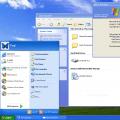Mathematical signs and symbols on the keyboard. Symbols on the keyboard: we want to print everything
Everyone can type today. Even the most staunch opponents of new technologies know how to type characters on the keyboard ( but don't do it out of principle). After all, all that is required is to find the key with the desired letter or punctuation mark and press it with your finger:
But sometimes situations arise when the desired character is simply not on the keyboard. For example, a person writes a text about the temperature at the South Pole, but there is no symbol for degrees. In this case, not only a beginner can get confused, but also enough advanced user (or the one who considers himself to be them).
But there is certainly a way out of this situation. When the characters on the keyboard do not meet the requirements, you must use other input methods. Some of them will be covered in this article.
Why isn't everything on the keyboard?
If you look just below the monitor screen, you can see different characters on the keyboard, which nevertheless look very familiar. They are used, oddly enough, in order to print, and mankind has been fond of this occupation for a long time.
Back in 1868, a typewriter was introduced to the world ( although they tried to do it a century earlier), the letters on it were in alphabetical order, and it took people 22 years to eliminate this inconvenience. In turn, in 1890, the QWERTY layout appeared, which migrated to modern keyboards.
Thus, the composition and arrangement of the main symbols were developed over the years, and over time, mankind did not come up with something radically new in this regard, but only improved the old.
Why do the keyboards remain the same, and there is no one who wants to capitalize on the novelty? You need to understand that large companies producing equipment should target a wide audience, so the symbols and signs on the keyboard are designed for the most common needs. To understand manufacturers, you need to define the categories of people who use computers.
- Regular users. They need to go online, check their mail and, in some cases, write small texts ( messages, announcements):

For these people, additional characters on the keyboard are not required, and even those that are there are too many.

Keyboard characters include the basic reserved constructs of many programming languages ( &, |, #, (), etc.). Such popular and most widely used languages as C, C ++, Lisp, Java have a well-established syntax, which was initially partially adapted to the characters available on the keyboard. Therefore, if now the standard layout changes significantly, this will lead to significant inconvenience for programmers, and this is not needed by anyone.
- Office workers. These comrades in most cases operate with numbers, so their needs closely overlap with programmers' needs:

Mathematical operations, percentage and dollar sign are the faithful companions of every report.
Needless to say, today everyone uses a computer everywhere. In many cases, people need to enter characters that are not on the keyboard. It can be some kind of scientific notation or simply means of display that are more suitable in a particular situation.
Thousands of keyboards would be needed to accommodate all the known symbols, but the keys have a wonderful property: they can be pressed several at a time. However, more on that later.
Special characters
We are used to the fact that a symbol is something visual, however, when formatting text, it is often necessary to indent and line breaks, which are ignored by the browser when displayed. In this case, apply Special symbols... They are not on the keyboard, but in the html-code you can, for example, write & nbsp, which will mean a non-breaking space.
Let's imagine another situation: you are writing an article about Internet technologies and want to give examples of html tags. But here's the bad luck: you know how to put symbols on the keyboard ( not small already), however the browser treats the tags as tags and does not display anything. In this case, special characters come to the rescue again.
Sometimes the authors of articles are faced with an intricate problem: how to write characters on the keyboard if they are not on it. The weak give up and use tricks, naming what they could not print. The initiates, on the other hand, turn to special characters and find what they need:

For example, 7 is a Jewish star; there is no symbol on the keyboard, but it comes in handy when writing religious texts.
Character codes
Above, we have already considered the codes of special characters in the html language, however, there are other ways to show what is not shown on the keyboard keys.
First of all, we should mention the encoding standards: ASCII, Unicode, UTF-8, which allow not only entering characters using the keyboard, but also setting them programmatically, when not the number 300 is displayed on the screen, but a beautiful heart ( if ASCII encoding is set).
There is a way to expand the existing characters on the keyboard - ALT -code. To enter characters in this way, you do not need to go to any special editor at all:

In order to know how to make symbols on the keyboard ( even those that are not there and about which you do not know), it is enough to have a sign in front of your eyes and, holding down the alt key, enter a sequence of numbers.
How to enter something that is not on the keyboard?
For those who do not know how to make characters on the keyboard that are not displayed on the keys, collecting together everything mentioned above, there are several ways.
- Take advantage of opportunities text editor... Programs such as Microsoft Word and its counterparts offer a ton of possibilities besides how to write characters on the keyboard ( drawing up formulas, displaying physical units, choosing different styles of punctuation marks). Therefore, you can safely type texts of any subject;
- Html special characters. Not knowing how to put characters on the keyboard while publishing articles in The world wide web, you can use the table of special characters. It will help display almost any known designation, but you should choose common fonts ( Arial, Times
Related materials
Hello dear friend.
[OBJECTIVE] Today we will consider characters that are not on the keyboard(graphic symbols). ❦
At one time, I had a chance to rummage through more than a dozen in the search for these characters, but what can I say, sooo many sites.
I think you will agree with me that the use of such elements in the text makes it more attractive and interesting ❀ More often, of course, these symbols are used in social networks, and now also in e-mail newsletters to make your appeal stand out from the crowd ✔
This symbolism is also called Unicode. What is it? To make it clearer, let's turn to
Unicod(most often) or Unicode(eng. Unicode) is a character encoding standard that allows characters to be represented in almost all written languages.
The standard was proposed in 1991 by the non-profit organization "Unicode Consortium" (eng. Unicode Consortium, Unicode Inc.) The use of this standard allows you to encode a very large number of characters from different scripts: in Unicode documents, Chinese characters, mathematical characters, letters of the Greek alphabet, Latin and Cyrillic alphabet can coexist, thus switching code pages becomes unnecessary.
The standard consists of two main sections: universal character set (eng. UCS, universal character set) and the family of encodings (eng. UTF, Unicode transformation format). The universal character set defines a one-to-one correspondence of characters to codes - elements of the code space that represent non-negative integers. The family of encodings defines the machine representation of a sequence of UCS codes.
Unicode codes are divided into several areas. The area with codes from U + 0000 to U + 007F contains the ASCII characters with the corresponding codes. Next are the areas of signs of various scripts, punctuation and technical symbols. Some of the codes are reserved for future use. Under the Cyrillic characters areas of characters with codes from U + 0400 to U + 052F, from U + 2DE0 to U + 2DFF, from U + A640 to U + A69F are allocated (see Cyrillic in Unicode).
Now that the picture has cleared up and we know how graphic symbols work and are displayed, I want to present to your attention a selection of the most common and popular symbols that are not on the keyboard, which means that you will not be able to use them with one keystroke.
Any of the presented symbols can be added to sites, social. network and working in Word.
Note! In some types of browsers, characters may not be displayed, and instead of them, incomprehensible characters or an empty square will be displayed. This is due to different technologies, browsers ( Mozilla FireFox, Chrome, Opera and IE), as well as the Windows version.
Otherwise, everything is in order. Enjoy it!Yes, I almost forgot ... In order to take the desired symbol, simply copy it by highlighting it with the mouse and paste it where you need it.
 How to put a lattice on a laptop How to type a hash symbol on a laptop
How to put a lattice on a laptop How to type a hash symbol on a laptop Windows operating system All types of Windows
Windows operating system All types of Windows Where is the file sharing site on the computer
Where is the file sharing site on the computer